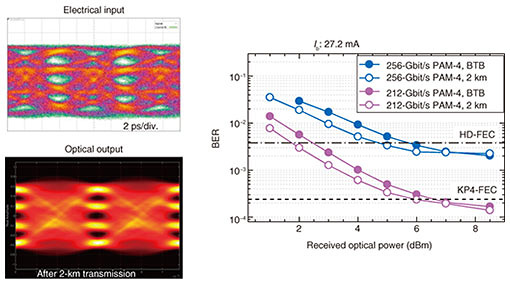 |
|||
|
|
|||
|
Short Reports Vol. 19, No. 3, pp. 72–73, Mar. 2021. https://doi.org/10.53829/ntr202103sr2 World°«s Fastest Directly Modulated Laser Exceeding 100-GHz Bandwidth1. IntroductionNTT in collaboration with Fumio Koyama, professor at the Laboratory for Future Interdisciplinary Research of Science and Technology, Tokyo Institute of Technology, has developed a membrane laser that uses an indium phosphide (InP) compound semiconductor on a silicon carbide (SiC) substrate with high thermal conductivity. This laser, the world’s first directly modulated laser with a 3-dB bandwidth exceeding 100 GHz, can transmit at 256 Gbits (256 billion bits) per second over a distance of 2 km. Directly modulated lasers are now widely used in datacenter interconnections, but their modulation speed is limited, which has been a problem for further increasing transmission capacity. Our membrane laser will enable us to respond to the expected increase in traffic with a low-cost and low-power-consumption solution and contribute to the development of a high-capacity optical transmission infrastructure that supports NTT’s IOWN (Innovative Optical and Wireless Network). This research was reported in Nature Photonics on October 19, 2020 [1]. 2. Research resultsTo increase the relaxation oscillation frequency, NTT researchers have focused on the optical confinement factor of the active region and developed a membrane laser on a silicon (Si) substrate with a thermal oxide (e.g., silicon dioxide (SiO2)) film. Membrane lasers have a large optical confinement factor in the active region and are compact, making it possible to develop directly modulated lasers with low power consumption. Since such devices are fabricated on a low-thermal-conductivity SiO2 layer, the temperature increase in the active layer due to current injection is large. Even if the current is increased, the relaxation oscillation frequency saturates at about 20 GHz due to saturation of the differential gain. To suppress the increase in the active-region temperature, we fabricated InP-based membrane lasers on a SiC substrate, which has a thermal conductivity approximately 500 times higher than that of SiO2. Since SiC has a lower refractive index than InP, the optical confinement factor is almost the same as that of the device on SiO2. The membrane laser was fabricated by direct bonding with ultrathin (40 nm) SiO2 between the InP layer and SiC substrate. Assuming a 100-mW heat source, the temperature increase in the active region of a membrane laser with an active layer length of 50 μm was significantly reduced from 130.9 to 16.8°C when the SiO2 thickness was reduced from 2 μm to 40 nm. The current at which the relaxation oscillation frequency reaches its maximum was 5.5 mA for a membrane laser fabricated on SiO2/Si substrate. In contrast, with the membrane laser fabricated on SiC substrate, we were able to increase the current to 30 mA and obtain the world’s highest relaxation frequency of 42 GHz and a 3-dB bandwidth of 60 GHz. In addition, using optical feedback from the end facet of the output waveguide, we designed the device in which photon-photon resonance occurs at around 95 GHz. As a result, we obtained a 3-dB bandwidth of 108 GHz and succeeded in generating a 256-Gbit/s (256 billion bits per second) pulse amplitude modulation (PAM)-4 signal and transmitting it over a distance of 2 km (Fig. 1).
3. Future developmentsThe future will see the development of transmitters capable of handling the next generation of Ethernet standards with transmission capacity exceeding 1 terabit with four or eight arrays. The simultaneous achievement of low power consumption is expected to suppress increases in the power consumption of datacenters and supercomputers due to the anticipated increase in data volume. Reference
For inquiries:Public Relations, NTT Science and Core Technology Laboratory Group |
|||









